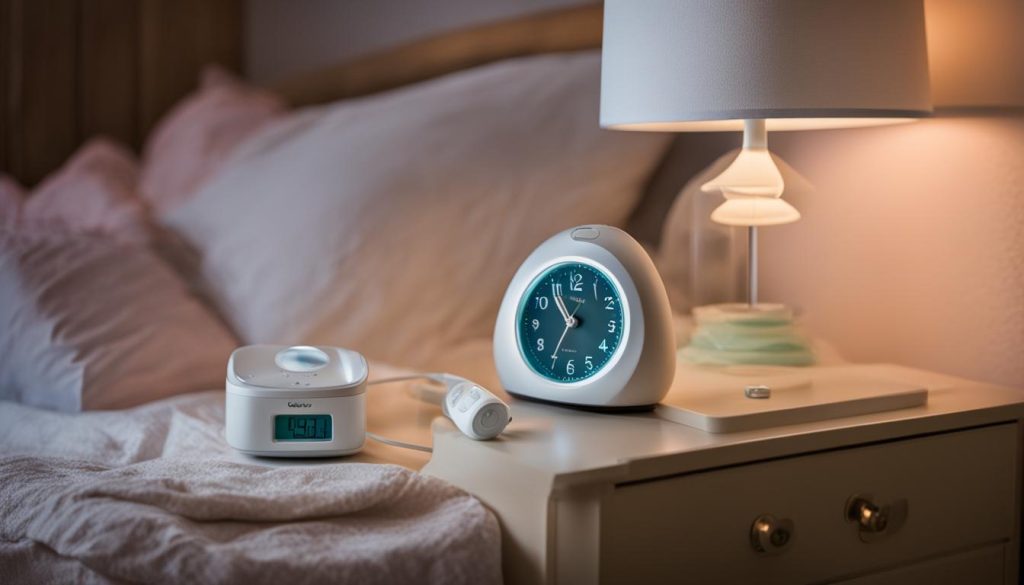Pumping at night is crucial for mothers who want to ensure successful nighttime pumping, maximize their milk supply, and increase breast milk production during this time. Finding the optimal pumping time at night is essential for maintaining a healthy milk supply.
As a mother myself, I understand the importance of pumping every 3-5 hours until the milk supply is well established, which usually happens around 10 weeks postpartum. To achieve the best results, I recommend pumping 1-2 times each night.
By pumping at night, we can ensure that our breasts are adequately stimulated, allowing our bodies to produce more milk during these hours. This not only helps us maintain our milk supply but also ensures that our little ones receive the nutrients they need.
So, let’s find the best time to pump at night and make the most out of our breastfeeding journey!
How Often Should I Pump at Night?
When it comes to nighttime pumping, many mothers wonder how often they should pump to maintain their milk supply. The frequency of pumping at night may vary depending on whether you are also directly breastfeeding your baby or exclusively expressing.
If your baby is breastfeeding throughout the night, you may not need to pump. However, if you want to maintain your milk supply or if you are exclusively expressing, it is recommended to pump every 3-5 hours at night. This means pumping 1-2 times each night. Establishing a consistent pumping schedule is essential for milk production and maintaining a healthy milk supply.
By pumping at night, you can ensure that your breasts are emptied regularly, signaling to your body to produce more milk. This can help with milk production and prevent engorgement. Additionally, pumping at night can provide you with a stash of milk for times when you may be away from your baby or need to offer a bottle.
Tips for Easier Nighttime Pumping
Pumping at night can be a challenging task for many breastfeeding mothers, but with some simple tips, you can make the process easier and more efficient. Here are some strategies to consider:
1. Breast Pump Before Bed
One effective way to streamline nighttime pumping is to pump right before bed. This allows you to empty your breasts and stimulate milk production while also ensuring a more comfortable sleep. By removing milk before going to sleep, you can avoid engorgement and promote a healthy milk supply.

2. Prepare Pump Parts
Prior to bedtime, make sure all your pump parts are clean and ready for use. This includes disassembling and washing any removable components, such as breast shields, valves, and tubing. Having your pump parts prepared in advance saves you time and effort during those late-night pumping sessions.
3. Set Up a Pumping Station
Designate a specific area in your bedroom or nursery as your pumping station. Keep all necessary supplies within reach, such as extra bottles, breast milk storage bags, and a water bottle for hydration. Creating a comfortable and organized pumping space helps you stay focused and minimizes disruptions during nighttime pumping.
4. Snacks and Water for Pumping
Keep a stash of healthy snacks and a bottle of water near your pumping station. Nighttime pumping sessions can be draining, so it’s important to nourish your body and stay hydrated. Choose nutritious snacks like granola bars, nuts, or cut-up fruits to keep your energy levels up.
5. Labeling Milk Storage Bags
To avoid confusion, label your breast milk storage bags with the date and time of pumping. This ensures that you can easily track when the milk was expressed and prioritize its use based on freshness. Using waterproof markers or adhesive labels can help prevent the labels from smudging or fading over time.
6. Setting Alarms for Pumping
If you tend to sleep deeply or are concerned about forgetting your pumping sessions, consider setting alarms on your phone or using a wearable device with a vibrating alarm. This will help you stay on schedule and maintain a consistent pumping routine, even during the night.
By implementing these tips, you can make nighttime pumping more manageable and less disruptive to your sleep routine. Remember to prioritize self-care and find a pumping schedule that works best for you and your baby.
Pumping at Night vs. Partner Feeding
When it comes to meeting the nighttime feeding needs of your baby, there are two options to consider: pumping breast milk or partner feeding. While both have their benefits, it’s essential to understand the implications for maintaining your milk supply and ensuring your baby’s nutrition.
Partner feeding at night can be a great way to allow the mother to get more sleep, especially during the early weeks when exhaustion is common. Having your partner handle some of the nighttime feedings can provide much-needed rest and support. However, it’s important to note that partner feedings should not replace regular breastfeeding or pumping sessions that directly stimulate your milk supply.

While partner feeding can give you a break, it’s crucial to continue breastfeeding or pumping every 2-3 hours in the first three months and every 3-4 hours in the following three months to maintain your milk supply. Your baby’s demand for milk is what signals your body to produce more, so consistent breastfeeding or pumping is essential.
Pumping at night has its own set of benefits. By pumping during the nighttime hours, you can maximize milk production during this time, as the body tends to produce more milk in the early morning hours. This can help ensure a healthy milk supply to meet your baby’s needs throughout the day. Additionally, pumping at night can also be an effective way to relieve engorgement and maintain milk flow.
Ultimately, finding the right balance between partner feeding and pumping at night is a personal decision. It’s important to prioritize your own well-being and rest, while also ensuring that your baby’s nutritional needs are met and your milk supply is maintained. Consulting with a lactation consultant can provide valuable guidance and support as you navigate nighttime feeding options.
Best Times to Pump to Increase Milk Supply
Introducing pumping to your breastfeeding routine can be a game-changer when it comes to increasing your milk supply. After your baby’s first growth spurt, which typically occurs around 11-14 days after birth for term babies, you can start incorporating pumping sessions into your day. It’s best to pump after nursing sessions to ensure that your breasts are adequately stimulated and can produce enough milk for the next feeding.
One optimal time for pumping to increase milk supply is in the morning when your milk production tends to be at its highest. Double pumping both breasts in the morning can help you empty your breasts fully and send a signal to your body to produce more milk throughout the day. Plus, it’s a great way to start the day feeling refreshed and ready to take on the world!
Another strategic time to pump is right before bed. Pumping before you hit the sheets can stimulate the release of oxytocin, the hormone responsible for milk letdown. Not only will this help you relax and have a more restful sleep, but it will also support your milk supply. Sneaking in a quick pump session in the middle of the night can also provide relief from engorgement and prevent discomfort.
Lastly, power pumping can be a game-changer for boosting your milk supply. Power pumping involves pumping for short periods of time with short breaks in between to mimic the baby’s cluster feeding behavior. This method can help stimulate your breasts to produce more milk and increase your overall milk supply. Give it a try if you’re looking for an extra boost!
FAQ
What is the best time to pump at night?
The best time to pump at night is 1-2 times, spaced every 3-5 hours, to maximize milk supply and ensure successful pumping sessions.
How often should I pump at night?
If you’re exclusively expressing or want to maintain your milk supply, it is recommended to pump every 3-5 hours until your milk supply is well established, usually around 10 weeks postpartum. Pumping 1-2 times each night is ideal.
Do I need to pump at night if my baby breastfeeds throughout the night?
If your baby breastfeeds throughout the night and you are not exclusively expressing, pumping at night may not be necessary. However, if you want to maintain your milk supply or are exclusively expressing, pumping every 3-5 hours at night is important.
How can I make nighttime pumping easier?
To make nighttime pumping easier, you can try pumping after nursing sessions, double pumping both breasts in the morning, pumping right before bed to stimulate the hormone oxytocin for better sleep, and sneaking in a quick pump session in the middle of the night for relief from engorgement.
Should partner feedings replace regular breastfeeding or pumping sessions?
Partner feedings should not replace regular breastfeeding or pumping sessions. It is important to breastfeed or pump every 2-3 hours in the first three months and every 3-4 hours in the following three months to maintain your milk supply. Partner feedings can occasionally be done to allow you to get more sleep, but the baby’s demand for milk is essential for maintaining supply.
When is the best time to introduce pumping to increase milk supply?
The best time to introduce pumping to increase milk supply is after the baby’s first growth spurt, which occurs around 11-14 days after birth for term babies. Pumping after nursing sessions can ensure adequate milk supply for the next feeding.






